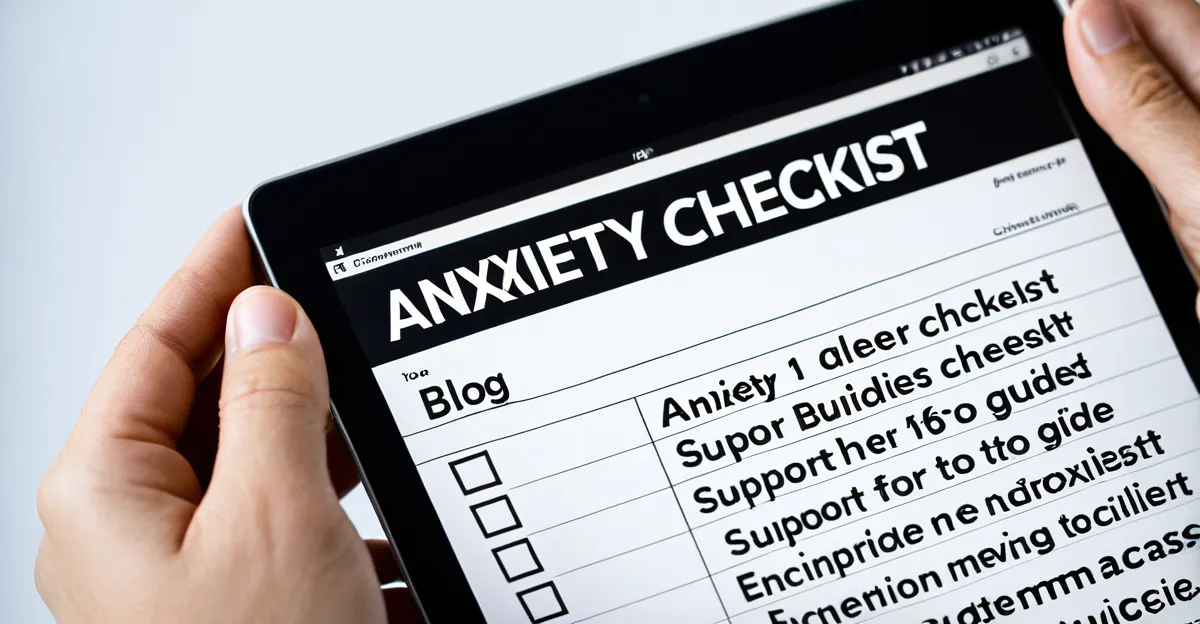Anxiety can be difficult to recognise and measure without a clear framework. This checklist breaks down key symptoms and their frequency, offering a straightforward way to assess your level of anxiety. By understanding how these signs affect daily life, you can decide whether to seek further support or professional help, empowering you to take control with confidence and clarity.
Essential Checklist and Tools for Identifying and Assessing Anxiety
A comprehensive approach to understanding anxiety starts with practical self-assessment. The Anxiety Checklist brings together recognized tools like the GAD-7 alongside printable resources to support adults in recognizing their symptoms. These checklists typically ask about experiences such as nervousness, restlessness, trouble relaxing, and frequent worrying, all assessed over the previous two weeks. Each symptom is rated by how often it occurs, helping individuals gauge severity and impact on daily life.
Topic to read : Mastering chronic fatigue syndrome: essential strategies for successful management – an in-depth guide to empower your path
To use a printable anxiety symptom list, review each statement honestly and select the response that best reflects your recent experience. After completing the checklist, add up your scores for a total indicative value; many checklists suggest thresholds (for example, a GAD-7 score of 10 or more) as a sign to consider reaching out for professional support.
Proper interpretation means not only noting your score but also reflecting on whether anxiety symptoms interfere with work, relationships, or well-being. If these indicators are present, guidance suggests consulting a mental health provider or accessing confidential support lines. Structured self-assessment is only a first step; ongoing concerns deserve a tailored, professional approach.
Also to see : Unlock low-impact cardio routines to soothe knee pain: the ultimate fitness manual for safety and ease
Understanding Anxiety and Its Symptoms
Prevalence studies using tools like the GAD-7 show that anxiety disorders affect people across all ages and backgrounds. The presentation of child anxiety signs and symptoms can differ from adults, requiring close attention to both emotional and physical anxiety indicators. For children, behaviors such as frequent stomachaches, irritability, and difficulty concentrating often serve as early warning signs, while adolescents may display increased withdrawal or sudden mood changes. In adults, trouble relaxing, persistent worry, and sleep disturbances rank among the most common physical symptoms of generalized anxiety disorder.
Clear emotional and physical anxiety indicators may include muscle tension, racing heart, excessive fears, and overwhelming dread. Recognizing anxiety triggers—such as social events, school pressures, or family changes—can help individuals identify patterns. For instance, in students, increased school avoidance or somatic complaints may highlight anxiety and depression early warning signs.
Identifying and tracking these symptoms through tools like a printable anxiety symptom list or a daily mood and anxiety checklist can promote early intervention. Ongoing monitoring of physical symptoms of generalized anxiety disorder and emotional and behavioral shifts fosters proactive management, especially in vulnerable populations.
Strategies, Tools, and Resources for Managing Anxiety
Anxiety relief checklist tools ground immediate steps for anxiety relief with tangible methods. A well-structured effective anxiety self-help checklist can break overwhelming symptoms into manageable actions. Such checklists often focus on simple self-care strategies for anxiety relief—examples include deep breathing exercises, mindful journaling, and short daily walks. Paired with an emotional health daily checklist, these routines promote sustainable anxiety prevention daily habits and managing anxiety symptoms naturally.
For tracking progress, printable worksheets and digital apps allow ongoing anxiety symptom monitoring. Worksheets guide users to document triggers, emotional shifts, and coping strategies for panic attacks, serving as essential resources for managing anxiety symptoms naturally. An anxiety symptom journal template enables regular reflection, identification of stressors, and customized adjustments of routines—key for developing daily anxiety management tips.
Support systems amplify these benefits. Community-based forums, professional resources, and outreach services can be incorporated into a comprehensive self-care plan. Emotional health daily checklist sharing—in professional guidance or peer-support settings—honors both privacy and connection. Routine use of an anxiety relief checklist with these support systems builds resilience, empowers better choices, and roots anxiety prevention daily habits into everyday life.




